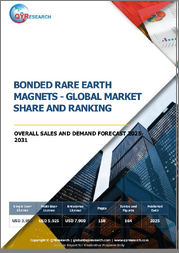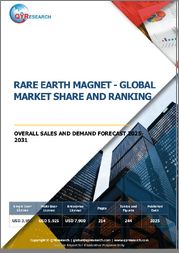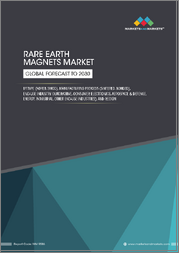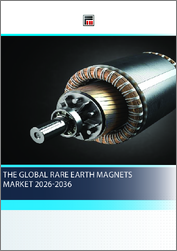
|
시장보고서
상품코드
1775275
세계의 희토류 자석 시장 평가 : 유형별, 최종사용자별, 지역별, 기회, 예측(2018-2032년)Global Rare Earth Magnets Market Assessment, By Type, By End-user, By Region, Opportunities and Forecast, 2018-2032F |
||||||
세계의 희토류 자석 시장 규모는 2025-2032년의 예측 기간 중 7.43%의 CAGR로 확대하며, 2024년 183억 2,000만 달러에서 2032년에는 325억 1,000만 달러로 성장할 것으로 예측됩니다. 희토류 자석 시장은 전기자동차(EV)의 급속한 보급과 첨단 가전제품의 보급으로 최근 큰 폭의 성장세를 보이고 있으며, 앞으로도 견고한 성장세를 유지할 것으로 예측됩니다. 희토류 자석은 주로 네오디뮴, 사마륨, 디스프로슘 등의 합금으로 만들어지며, 그 엄청난 자력으로 가장 잘 알려져 있습니다. 희토류 자석은 현대의 광범위한 용도에 사용될 수 있으며, EV 산업에서 희토류 자석은 고성능 모터 및 회생 제동 시스템 제조에 사용되어 전체 시장 수요를 촉진하고 있습니다. 또한 재생에너지 인프라, 특히 효율적인 에너지 전달을 위해 강력하고 내구성이 강한 자석이 필요한 풍력 터빈의 설치도 희토류 자석 시장의 성장을 지원하고 있습니다. 희토류 자석은 다양한 용도로 사용되므로 수요 증가에 대응하기 위해 제조 기업은 새로운 생산 공장에 투자하고 있습니다.
예를 들어 2025년 4월, Solvay S.A.는 프랑스 라로셸 공장에 영구 자석용 희토류 생산 라인을 개설하기로 결정했습니다. 영구자석용 희토류의 상업적 생산은 전기자동차 모터, 재생에너지, 첨단 전자제품, 방위시스템에 필수적인 부품입니다. 이 시설은 중요 원자재 법에 따라 다양한 공급업체와 채굴 파트너로부터 희토류 및 재활용 재료를 조달할 예정입니다. 이번 개발을 통해 회사는 향후 수년간 희토류 자석 시장의 세계 리더로서 입지를 다질 수 있을 것으로 기대하고 있습니다.
가전제품 산업은 고성능 및 소형화를 위해 첨단 소재에 대한 수요가 증가하고 있으며, 이는 향후 수년간 희토류 자석 산업의 성장으로 이어질 것으로 예측됩니다. 또한 모터, 센서, 액추에이터 등 다양한 부품 제조에 재료가 적용되므로 산업 자동화 및 의료기기 관련 향후 개발이 시장 개발에 기여할 것입니다. 또한 희토류 자석은 국방 시스템 및 무기에 사용되어 시장 수요를 견인하고 있습니다. 즉, 지속적인 기술 혁신과 개발, 세계 에너지 수요 증가, 국방 시스템 업그레이드, 지속가능성을 향한 지속적인 움직임이 희토류 자석 시장의 성장을 가속하고 있습니다.
예를 들어 2024년 3월 미국 국방부는 미국의 중요한 군 무기 시스템에 사용되는 영구 자석 제조에 필요한 희토류 재료와 자석에 대한 지속적인 접근을 보장하기 위해 국내 공급망 개발을 검토하고 있습니다. 이 개발은 희토류 자석에 대한 수요가 향후 수년간 증가할 것임을 강조하고 있습니다.
신흥 시장과 선진국 시장 모두에서 전기자동차에 대한 수요가 상당한 비율로 증가하고 있으며, 시장에서의 부품 생산이 확대되고 있습니다. 여러 전기자동차(EV) 제조업체들은 고성능 전기모터 제조에 사용할 수 있는 첨단 소재를 찾고 있습니다. 제조업체들은 희토류 자석, 특히 네오디뮴-철-붕소(NdFeB) 자석을 채택하고 있으며, 이 소재는 전기 모터의 효율을 향상시킬 수 있으므로 향후 수년간 희토류 자석 시장 규모를 확대할 것으로 예측됩니다.
예를 들어 2025년 첫 5개월 동안에만 720만 대가 판매될 것으로 예상되며, 중국, 유럽 등 주요 시장에서의 전기화 속도가 빨라지고 있습니다. 양국의 전기자동차 보급은 정부 지원 정책, 충전 인프라 확대, 소비자 수용성 증가에 힘입어 전기자동차 생산을 촉진하여 희토류 자석에 대한 시장 수요를 촉진하고 있습니다.
또 다른 예로, 인도에서는 2025년 6월 전기 승용차가 인도 전체 승용차 판매량의 4% 이상을 차지하여 전년 동기 2.6%에서 크게 증가했습니다. 또한 2025년 5월 전기자동차 소매 판매량은 12,304대로 2024년 같은 달 8,029대에 비해 증가했으며, 4월 판매량은 약 1만 2,233대로 전월 대비 안정적 수요를 보이고 있습니다. 이는 중국내 전기자동차 수요 증가를 강조하며, 희토류 자석 수요를 견인할 것으로 예측됩니다.
또한 전기자동차 한 대당 보통 몇 킬로그램의 재료가 모터, 회생 제동 시스템, 보조 부품 제조에 필요하므로 전기자동차 수요의 급증은 희토류 자석 수요를 직접적으로 증가시킬 것입니다. 또한 EV 기업은 EV 포트폴리오를 확장하고 있으며, 이에 따라 희토류 자석 시장 규모를 더욱 확대할 수 있습니다. 마찬가지로 버스, 이륜차, 삼륜차, 상용차 등 다른 차량 부문도 전기화됨에 따라 희토류 자석 시장 동향은 예측 기간 중 상승세를 보일 것으로 예측됩니다. 강화된 배기가스 규제와 더 깨끗한 운송 수단에 대한 소비자 수요가 시장에서 고급 영구 자석 모터에 대한 수요를 촉진할 것으로 예상되기 때문입니다. 결국, EV 시장의 확대와 희토류 자석 소비의 시너지 효과는 그린 모빌리티로의 전환을 촉진하여 희토류 자석 시장 점유율 성장에 기여하는 결정적인 특징이 될 것으로 예측됩니다.
세계의 희토류 자석 시장에 대해 조사했으며, 시장의 개요와 유형별, 최종사용자별, 지역별 동향 및 시장에 참여하는 기업의 개요 등을 제공하고 있습니다.
목차
제1장 프로젝트 범위와 정의
제2장 조사 방법
제3장 미국 관세의 영향
제4장 개요
제5장 고객의 소리
제6장 세계의 희토류 자석 시장 전망, 2018-2032년
- 시장 규모 분석과 예측
- 시장 점유율 분석과 예측
- 유형별
- 네오디뮴 자석(NdFeB)
- 사마륨 코발트 자석(SmCo)
- 최종사용자별
- 자동차 산업
- 발전
- 의료
- 가전
- 기타
- 지역별
- 북미
- 유럽
- 아시아태평양
- 남미
- 중동 및 아프리카
- 기업별 시장 점유율 분석(상위 5사 및 기타 - 금액별, 2024년)
- 유형별
- 2024년 시장 맵 분석
제7장 북미의 희토류 자석 시장 전망, 2018-2032년
- 시장 규모 분석과 예측
- 시장 점유율 분석과 예측
- 국가별 시장 평가
- 미국
- 캐나다
- 멕시코
제8장 유럽의 희토류 자석 시장 전망, 2018-2032년
- 독일
- 프랑스
- 이탈리아
- 영국
- 러시아
- 네덜란드
- 스페인
- 튀르키예
- 폴란드
제9장 아시아태평양의 희토류 자석 시장 전망, 2018-2032년
- 인도
- 중국
- 일본
- 호주
- 베트남
- 한국
- 인도네시아
- 필리핀
제10장 남미의 희토류 자석 시장 전망, 2018-2032년
- 브라질
- 아르헨티나
제11장 중동 및 아프리카의 희토류 자석 시장 전망, 2018-2032년
- 사우디아라비아
- 아랍에미리트
- 남아프리카공화국
제12장 수요공급 분석
제13장 수출입의 분석
제14장 밸류체인 분석
제15장 Porter's Five Forces 분석
제16장 PESTLE 분석
제17장 가격 분석
제18장 시장 역학
- 시장 촉진요인
- 시장이 해결해야 할 과제
제19장 시장 동향과 발전
제20장 경쟁 구도
- 시장 리더 TOP 5의 경쟁 매트릭스
- 참여 기업 TOP 5의 SWOT 분석
- TOP 10 시장 기업의 주요 기업 상황
- Ningbo Zhaobao Magnet Co., Ltd.
- Zhejiang Sheensen Magnetics Technology Co. Ltd.
- Ningbo Tongchuang Magnetic Materials Co., Ltd.
- MP Materials Corp.
- Rare Earth Magnetics Private Limited
- Star Trace Solutions Private Limited
- Ningbo Yunsheng Co., Ltd.
- Neo Performance Materials Inc.
- Ningbo Ninggang Permanent Magnetic Materials Co., Ltd.
- Hangzhou Permanent Magnet Group. Ltd.
제21장 전략적 제안
제22장 조사회사 소개·면책사항
KSA 25.07.31Global rare earth magnets market is projected to witness a CAGR of 7.43% during the forecast period 2025-2032, growing from USD 18.32 billion in 2024 to USD 32.51 billion in 2032. The rare earth magnets market has experienced significant growth in recent years due to the rapid adoption of electric vehicles (EVs) and proliferation of advanced consumer electronics is expected to maintain a strong pace of expansion in the coming years. The rare earth magnets, mainly made of alloys like neodymium, samarium, and dysprosium, which are best known for their immense magnetic strength. Rare earth magnets can be employed in an extensive range of contemporary uses. In EV industry, the rare earth magnets are employed for producing high-performance motors and regenerative braking system that fuels its demand across the market. Furthermore, the installation of renewable energy infrastructure, especially wind turbines which require strong, hard-wearing magnets for efficient energy transfer, also supports the growth of the rare earth magnets market. As rare earth magnets have several applications so to fulfil the rising demand manufacture are investing in new production plants.
For instance, in April 2025, Solvay S.A. has decided to open its rare earths production line for permanent magnets at the La Rochelle facility, France which mark a significant milestone in the Group's commitment to meeting Europe's strategic goals. The commercial production of rare earths for permanent magnets is essential components in electric vehicle motors, renewable energy, advanced electronics and defense systems. The facility will source rare earths and recycled materials from a diverse range of suppliers and mining partners, as mandated by the Critical Raw Materials Act. This development will help the company to position as a global leader in the rare earth magnets market in the coming years.
The consumer electronics industry is increasing the demand for advanced materials to miniaturize its products with high performance, which leads to the rare earth magnets industry's growth in the coming years. Further, the upcoming developments pertaining to industrial automation and medical devices contribute to market growth as materials are applied in manufacturing numerous components like motors, sensors, and actuators. In addition, rare earth magnets are used in defense systems and weapons which drive demand in the market. In short, the continuous innovation and development, advancing world energy demands, defense system upgrades and the ongoing move toward sustainability are driving the rare earth magnets market growth.
For instance, in March 2024, United States Department of Defense is looking to develop domestic supply chains to ensure continued access to the rare earth materials and magnets needed to manufacture the permanent magnets which are used in important United States military weapons systems. This development highlights that the demand for rare earth magnets to increase in the coming years.
Rapid Growth in EV Production Amplifying the Market size.
Both in developing and developed nations, the demand for EVs rises on a significant rate which amplifies the production of the component in the market. Several manufacturers of electric vehicles (EV) are looking for advanced materials which could be used to produce high-performance electric motors. Manufacturers are adopting the rare earth magnets, particularly neodymium-iron-boron (NdFeB) magnets as material has the ability to improve the efficiency of the electric motor which boosts rare earth magnets market size in the coming years.
For instance, in 2025, 7.2 million units sold in the first five months alone, highlighting the accelerating pace of electrification across major markets such as China and Europe. The adoption of EVs in both countries is driven by supportive government policies, expanding charging infrastructure, and growing consumer acceptance which is boosting the production of EV thereby driving the demand for rare earth magnets in the market.
In another instance, in June 2025, In India, electric passenger vehicles captured more than 4 per cent of India's total passenger car sales in May 2025, representing a substantial increase from the 2.6 per cent market share recorded in the corresponding period last year. Moreover, retail sales reached 12,304 electric cars in May 2025, compared to 8,029 units sold during the same month in 2024. April sales are approx. 12,233 units, showing month-on-month stability in demand of EV in the country. This development highlights the rising demand for EVs in the country which will drive the demand for rare earth magnets in the market.
Furthermore, with the surge in EV demand directly boost the demand or rare earth magnets, as each EV typically requires several kilograms of material for manufacturing motors, regenerative braking systems, and auxiliary components. Moreover, EV companies are expanding the EV portfolio which further broadens the addressable rare earth magnets market size. Similarly, the electrification of other vehicle segments such as buses, two- and three-wheelers, and commercial fleets will take rare earth magnets market trends upwards in the forecast period. As stricter emissions regulations and consumer demand for cleaner transport, drive the demand for advanced permanent magnet motors in the market. Ultimately, the synergy between EV market expansion and rare earth magnet consumption is expected to remain a defining feature due to the push towards green mobility transition thereby contributing to the growth of rare earth magnets market share.
Rising Demand for Advanced Consumer Electronics Gadgets Creates Market Opportunity
Consumers around the global are seek devices which are more compact, lightweight, and feature-rich electronic gadgets such as smartphones, laptops, hard disk drives, speakers, and headphones. Manufacturers of consumer electronics are adopting advanced materials primarily neodymium-based alloys for miniaturization and enhanced performance of the products which creates an opportunity for rare earth magnets market to grow in the coming years.
For instance, as per the National Bureau of Statistics (NBS) report in 2024, China's mobile phone production was 1.68 billion units, up 7.3% YoY, and the demand for NdFeB was around 3,362 mt. In 2024, the government came up with the "national subsidy" policy which provided generous purchase subsidies for consumers, significantly stimulating market demand. This development highlights that the government is also supporting the in-house manufacturing which drives the demand for rare earth magnets in the coming years.
These magnets enable high-quality audio, haptic feedback, and efficient power management in ever-smaller form factors thus driving its demand in the market. Moreover, the trend toward miniaturization, portability and multifunctionality in consumer gadgets has made rare earth magnets a critical material for the sector. The rare earth magnets support technological innovation with the integration of advanced features without compromising device size due to which the demand for rare earth magnets is increasing in the market. As per the rare earth magnets market forecast, the adoption of smart home devices, wireless accessories, and next-generation wearables creates opportunities for market growth in the forecast period. In summary, the accelerating evolution of consumer electronics with several smarter, sleeker features is boosting the rare earth magnets market size.
Dominance of Neodymium Magnets (NdFeB) Segment in the Global Market
The demand for neodymium magnets (NdFeB) is increasing in the market as it is used in the electric vehicle (EV) sector. As automakers are moving towards the transition to clean mobility the demand for neodymium magnets (NdFeB) is growing rapidly in the global market. For the production of each EV typically requires between 2-5 kg of neodymium magnets for high-efficiency traction motors, with premium models using even more thereby the demand for neodymium magnets (NdFeB) segment will in increase in the coming years. Simultaneously, neodymium magnets (NdFeB) are high used in the production of wind turbines so with the global push for decarbonization and the expansion of wind power capacity will boost the demand for the segment in the forecast period.
The magnets enable high performance in increasingly smaller and lighter devices, meeting consumer expectations for advanced features and portability. Additionally, industrial automation, robotics, and medical devices use NdFeB magnets for their power, efficiency, and reliability. Ongoing technological innovation in magnet manufacturing, coupled with rising investments in energy storage, smart infrastructure, and sustainable technologies, further expands neodymium magnets (NdFeB) application opportunities.
Asia-Pacific Dominates Global Market
The demand for rare earth magnets is rapidly increasing in the Asia-Pacific region, driven by several factors such as growth in the electric vehicle (EV) sector and government support for in house production. The region is the hub of developing countries in which the investment in production activities is infused on regular intervals thus drive the demand for rare earth magnets in the market. As with the rising adoption of the EV in India and China as boosted the EV component production in the country which contributing to the large demand for the high-quality rare-earth magnets material in the market.
Moreover, government initiatives regarding the promotion of EV adoption and renewable energy have created a positive environment for rare earth magnet consumption. The rare earth magnets are highly used in the production of high-performance motors, wind turbines, and energy-efficient industrial machinery. Moreover, the production of consumer electronics which mainly relies on miniaturized, powerful magnets, has boosted the demand for rare earth magnets in the Asia-Pacific region. Advanced technological capabilities, cost-effective production, and heavy investment in infrastructure have solidified the region's dominance, making Asia-Pacific the largest producer and largest consumer of rare earth magnets in the world. Moreover, the production of rare earth materials is increasing in the region to support the rare earth magnet market growth.
For instance, in 2024, China's domestic output of rare earths was 270,000 metric tons in 2024 which is up from 255,000 metric tons from 2023. This development highlights that the country is increasing the production of rare earth metals which is further used to manufacture rare earth magnets, to fulfil the rising demand in the global market.
Impact of United States Tariff on Global Rare Earth Magnets Market
The tariffs and export restrictions led to a sharp drop (up to 75%) in rare earth magnet exports from China in the months following the policy changes, resulting in production halts and slowdowns at major automakers and electronics companies worldwide.
The United States imposed steep tariffs on rare earth magnets up to 125% in April 2025, raising import costs substantially and forcing United States suppliers and manufacturers to increase prices for end users.
The price volatility and uncertainty prompted efforts to diversify supply, including new investments in domestic rare earth mining and magnet manufacturing in the United States, however, building such capacity is expected to take years.
United States and European companies experienced acute shortages, with some factories facing imminent production cuts due to a lack of magnet supplies, highlighting the vulnerability of global supply chains.
For instance, On April 4, 2025, the China announced the implementation of export control policies for medium-heavy rare earth metals, which partially affected the rare earth magnets market.
Key Players Landscape and Outlook
To increase revenue and market share in the global rare earth magnet market, leading players are investing heavily in research and development. Companies are also diversifying supply chains to reduce dependence on single-source countries and mitigate geopolitical risks. Strategic moves include adopting advanced manufacturing techniques, developing alternative magnetic materials and recycling initiatives to address environmental concerns and cost pressures. Additionally, companies are forming alliances and partnerships for technology sharing and expanding production capacity in emerging markets to capture new demand. Product launches, agreements, business expansions, collaborations, and developing technologies are projected to increase competition in the fast-paced market.
For instance, in July 2023, NEO Performance Materials decided to build rare earth magnet manufacturing facility in Europe designed to produce specialized rare earth permanent magnets for use in electric vehicles, wind turbines, and other clean energy technologies. Based in Narva, Estonia, the plant expects to begin production of permanent rare earth magnets in 2025 sufficient to support the manufacturing of approximately 1.5 million electric cars. This development highlights that companies are increasing production capacity to fulfil rising needs.
Table of Contents
1. Project Scope and Definitions
2. Research Methodology
3. Impact of U.S. Tariffs
4. Executive Summary
5. Voice of Customer
- 5.1. Respondent Demographic
- 5.2. Factors Considered in Purchase Decisions
- 5.3. Unmet Needs
6. Global Rare Earth Magnets Market Outlook, 2018-2032F
- 6.1. Market Size Analysis & Forecast
- 6.1.1. By Value
- 6.1.2. By Volume
- 6.2. Market Share Analysis & Forecast
- 6.2.1. By Type
- 6.2.1.1. Neodymium Magnets (NdFeB)
- 6.2.1.2. Samarium-Cobalt Magnets (SmCo)
- 6.2.2. By End-user
- 6.2.2.1. Automotive Industry
- 6.2.2.2. Power Generation
- 6.2.2.3. Medical
- 6.2.2.4. Consumer Electronics
- 6.2.2.5. Others
- 6.2.3. By Region
- 6.2.3.1. North America
- 6.2.3.2. Europe
- 6.2.3.3. Asia-Pacific
- 6.2.3.4. South America
- 6.2.3.5. Middle East and Africa
- 6.2.4. By Company Market Share Analysis (Top 5 Companies and Others - By Value, 2024)
- 6.2.1. By Type
- 6.3. Market Map Analysis, 2024
- 6.3.1. By Type
- 6.3.2. By End-user
- 6.3.3. By Region
7. North America Rare Earth Magnets Market Outlook, 2018-2032F*
- 7.1. Market Size Analysis & Forecast
- 7.1.1. By Value
- 7.1.2. By Volume
- 7.2. Market Share Analysis & Forecast
- 7.2.1. By Type
- 7.2.1.1. Neodymium Magnets (NdFeB)
- 7.2.1.2. Samarium-Cobalt Magnets (SmCo)
- 7.2.2. By End-user
- 7.2.2.1. Automotive Industry
- 7.2.2.2. Power Generation
- 7.2.2.3. Medical
- 7.2.2.4. Consumer Electronics
- 7.2.2.5. Others
- 7.2.3. By Country Share
- 7.2.3.1. United States
- 7.2.3.2. Canada
- 7.2.3.3. Mexico
- 7.2.1. By Type
- 7.3. Country Market Assessment
- 7.3.1. United States Rare Earth Magnets Market Outlook, 2018-2032F*
- 7.3.1.1. Market Size Analysis & Forecast
- 7.3.1.1.1. By Value
- 7.3.1.1.2. By Volume
- 7.3.1.2. Market Share Analysis & Forecast
- 7.3.1.2.1. By Type
- 7.3.1.2.1.1. Neodymium Magnets (NdFeB)
- 7.3.1.2.1.2. Samarium-Cobalt Magnets (SmCo)
- 7.3.1.2.2. By End-user
- 7.3.1.2.2.1. Automotive Industry
- 7.3.1.2.2.2. Power Generation
- 7.3.1.2.2.3. Medical
- 7.3.1.2.2.4. Consumer Electronics
- 7.3.1.2.2.5. Others
- 7.3.1.2.1. By Type
- 7.3.1.1. Market Size Analysis & Forecast
- 7.3.2. Canada
- 7.3.3. Mexico
- 7.3.1. United States Rare Earth Magnets Market Outlook, 2018-2032F*
All segments will be provided for all regions and countries covered
8. Europe Rare Earth Magnets Market Outlook, 2018-2032F
- 8.1. Germany
- 8.2. France
- 8.3. Italy
- 8.4. United Kingdom
- 8.5. Russia
- 8.6. Netherlands
- 8.7. Spain
- 8.8. Turkey
- 8.9. Poland
9. Asia-Pacific Rare Earth Magnets Market Outlook, 2018-2032F
- 9.1. India
- 9.2. China
- 9.3. Japan
- 9.4. Australia
- 9.5. Vietnam
- 9.6. South Korea
- 9.7. Indonesia
- 9.8. Philippines
10. South America Rare Earth Magnets Market Outlook, 2018-2032F
- 10.1. Brazil
- 10.2. Argentina
11. Middle East and Africa Rare Earth Magnets Market Outlook, 2018-2032F
- 11.1. Saudi Arabia
- 11.2. UAE
- 11.3. South Africa
12. Demand Supply Analysis
13. Import and Export Analysis
14. Value Chain Analysis
15. Porter's Five Forces Analysis
16. PESTLE Analysis
17. Pricing Analysis
18. Market Dynamics
- 18.1. Market Drivers
- 18.2. Market Challenges
19. Market Trends and Developments
20. Competitive Landscape
- 20.1. Competition Matrix of Top 5 Market Leaders
- 20.2. SWOT Analysis for Top 5 Players
- 20.3. Key Players Landscape for Top 10 Market Players
- 20.3.1. Ningbo Zhaobao Magnet Co., Ltd.
- 20.3.1.1. Company Details
- 20.3.1.2. Key Management Personnel
- 20.3.1.3. Products and Services
- 20.3.1.4. Financials (As Reported)
- 20.3.1.5. Key Market Focus and Geographical Presence
- 20.3.1.6. Recent Developments/Collaborations/Partnerships/Mergers and Acquisition
- 20.3.2. Zhejiang Sheensen Magnetics Technology Co. Ltd.
- 20.3.3. Ningbo Tongchuang Magnetic Materials Co., Ltd.
- 20.3.4. MP Materials Corp.
- 20.3.5. Rare Earth Magnetics Private Limited
- 20.3.6. Star Trace Solutions Private Limited
- 20.3.7. Ningbo Yunsheng Co., Ltd.
- 20.3.8. Neo Performance Materials Inc.
- 20.3.9. Ningbo Ninggang Permanent Magnetic Materials Co., Ltd.
- 20.3.10. Hangzhou Permanent Magnet Group. Ltd.
- 20.3.1. Ningbo Zhaobao Magnet Co., Ltd.
Companies mentioned above DO NOT hold any order as per market share and can be changed as per information available during research work.


















